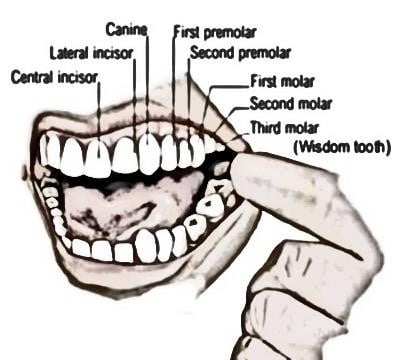TYPES OF TEETH
Human beings have two sets of teeth in their lifetime. The first set is called the milk teeth that grow when the child is few months old. They are about twenty (20) in numbers. These include only three types of teeth i.e. Incisors, canine and premolars. They later fall off to be replaced by the second set of teeth that consists of thirty-two permanent teeth. These are found in adult mammals. They are usually of four types: Incisors, canine, premolars and molars. These permanent teeth remain till old age.
Table of Contents
The teeth in mammals are of four major types:
Incisors: Flat, chisel-shaped with a sharp edge. They are used for biting food, cutting and holding onto a prey to prevent its escape.
Canine: similar to the incisors. They are sharp and pointed at the tips. They are used for tearing flesh and for catching a prey.
Premolars: They are large with rigid flat surfaces which are used for chewing food.
Molars: They are used for grinding and chewing food together with the premolar.
STRUCTURE OF A TOOTH
The mammal’s tooth is divided into three regions
- The crown which projects above the gum
- The root which is embedded in the jaw bones.
- The neck which is the junction between the crown and the root.

The centre of the tooth consists of a pulp cavity which contains blood vessels and nerves. These are extremely sensitive to heat and cold. A layer of dentine encloses the pulp. Dentine is a hard and bone-like material which contains some living cytoplasm. The enamel is a white layer covering the dentine and is the hardest material made by animals. Enamel protects the pulp and the dentine. A layer of cement covers the dentine in the root region.
DENTITION
Dentition is the number, arrangement and conformation of teeth in an organism. It is concerned with the number and kind of teeth present in the mouth of an organism e.g. mammals. The teeth are arranged and fixed to the lower and upper jaw bones.
Dentition is basically of two types
Homodont dentition: that in which organisms have the same type of teeth. No set of teeth is specialized for any function. All the teeth are of the same shape, size and function. This dentition is found in fishes, amphibians and reptiles.
Heterodont dentition: In this type, organisms have teeth of different shapes, sizes and functions. This observed in mammals.
Mammals, generally speaking, have four different types of teeth, namely; incisor, canines, premolars and molar. The type of teeth possessed by an animal is closely related to the type of food it eats.
DENTAL FORMULA
A formula expressing the number and kinds of teeth possessed by a mammal. A dental formula is usually written in the form of four ‘fractions’, one for each type of tooth, with the upper and lower lines describing the upper and lower jaws respectively. Different mammals have different dental formula depending on their diet. Examples include
Man………….2[ I=2/2, C=1/1, P=2/2, M=3/3] = 32.
Dog …………… 2[ I=3/3, C=1/1, P=4/4, M=2/3] = 42.
Cow …………….2[ I=0/3, C=0/1, P=3/3, M=3/3] = 32.
Lion…………… 2[ I=3/3, C=1/1, P=3/2, M=1/1] = 30.
Rabbit …………… 2[I= 2/1, C= 0/0, P=3/2, M=3/3] =28.
Sheep …………….. 2[I=0/3, C=0/1, P= 3/3, M= 3/3] =32.
Rat …………….. 2[I=1/1, C= 0/0, P=0/0, M=3/3] = 16

GENERAL EVALUATION
- What is dentition?
- Describe dentition in a named omnivore, carnivore and herbivore.
- Mention two types of dentition and give examples of organisms that possess each.
- List four types of teeth in mammals and their functions.
- With the aid of a labeled diagram, describe the structure of a tooth.
See also
CHROMOSOME | THE BASIS OF HEREDITARY
BIOLOGY OF HEREDITARY AND VARIATION (GENETICS)
ADAPTIVE COLOURATION AND BEHAVIOURAL ADAPTATION
